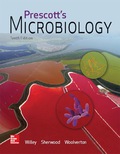
A diverse group of bacteria is present in the class of Clostridia. Clostridium is a Gram-positive, fermentative, and obligate anaerobic bacterium. Members belong to this genus have a great useful effect because they form endospores that are resistant to heat. They are responsible for spoilage of food in many cases, even foods that canned. Clostridium contains around a hundred (100) species that include essential pathogen and free-living bacteria.
Explanation of Solution
Some species of Clostridia are valuable in the industry. Example, Clostridium acetobutylicum because it manufactures butanol. The well-known toxin is also generated by this pathogenic species. Tetanus is caused by Clostridium tetani by the release of toxin (tetanospasmin).
Depends on the strain, Clostridium perfringens secretes a protein toxin. It causes the poisoning of food and gas gangrene. However, it lacks a tricarboxylic acid cycle (TCA). They generate ATP by fermentation. When this species present inside the human host, it has a doubling time of about 8 to 10 minutes. Apparently, this is due to the assimilation and readiness to supply macromolecules in the host.
A number of amino acids are also fermented by Clostridium tetani to butyrate, H2, and lactate. Both amino acids and carbohydrates are catabolized by Clostridium perfringens and Clostridium acetobutylicum. In contrast, Clostridium tetani lack the genes that catabolize molecule of sugars.
A simple experiment that demonstrates the pattern of the rapid growth rate of bacteria in the host that uses different types of growth media in vitro.
Experiment that would explore doubling time phenomenon are given below:
Two test tubes are taken, one tube is poured by a rich medium of amino acid and nitrate. Another tube is poured with medium only contains a minimum essential medium. An equal volume of Clostridium perfringens culture is inoculated with two test tubes. These tubes are tightly capped without leaving headspace. Then, inoculate the culture in an anaerobic environment.
It is clearly observed after 24 to 48 hours of incubation, Clostridium perfringens culture in amino acid and nitrate-rich medium shows high turbidity and it indicates the growth of cells. Due to the lowest growth of a cell, other tube shows less turbidity.
In this experiment, it is clearly shown that growth of the cell is differs, because Clostridium perfringens lacks tricarboxylic acid cycle (TCA). It mainly relies on organic compound fermentation for its growth. The energy is produced by using nitrate as the terminal electron acceptor. Thus, the body of humans provides a sufficient amount of amino acids and nitrates to the Clostridium perfringens growth. Therefore, Clostridium grows faster inside the host than in vitro.
Want to see more full solutions like this?
Chapter 23 Solutions
Prescott's Microbiology
- Why can it be said that N. equitans is both a carbon and anenergy parasite?arrow_forwardexplain:The process by which alteration in the genetic makeup of live type IIR bacteria was performed by heat killed type IIIS bacteria.arrow_forwardPart B: Antifungal agents are less selectively toxic than antibacterial agents meaning that they cause more damage to the host cells. Why is that the case?arrow_forward
- What causes Chlorella variabilis to be inaccessible to its host or has a narrow range of hosts? Please provide reference. Why is C. variabilis rigid layer of polysaccharides seen to be a challenge with genetic engineering like transformation? Please provide reference..arrow_forwardWhy are encapsolated bacteria generally more pathogenic than un-capsolated strains. a. Because capsule allows the organism to hide in the body of the host. b. because the capsule causes the phagocyte to mutate c. because the capsule protects bacteria from host immune cells d. because the capsule kills the phagocytes e. because the capsule stimulates a potent immune response in the host.arrow_forwardDescribe at least four mechanisms that would allow a bacterium X to compete with its host for iron.arrow_forward
 Comprehensive Medical Assisting: Administrative a...NursingISBN:9781305964792Author:Wilburta Q. Lindh, Carol D. Tamparo, Barbara M. Dahl, Julie Morris, Cindy CorreaPublisher:Cengage Learning
Comprehensive Medical Assisting: Administrative a...NursingISBN:9781305964792Author:Wilburta Q. Lindh, Carol D. Tamparo, Barbara M. Dahl, Julie Morris, Cindy CorreaPublisher:Cengage Learning



